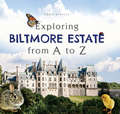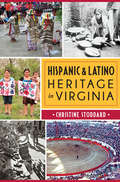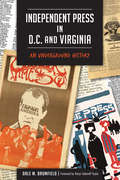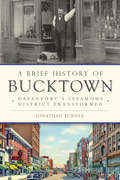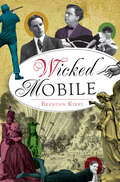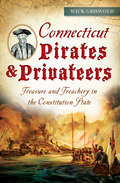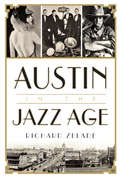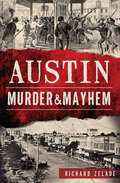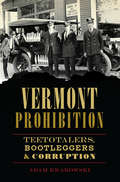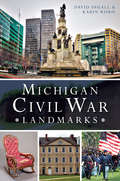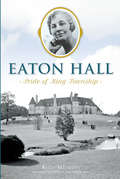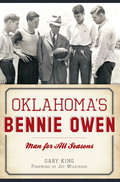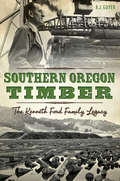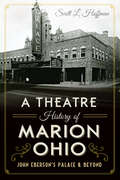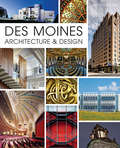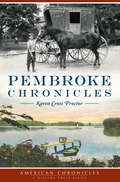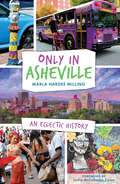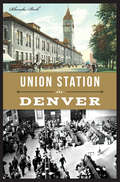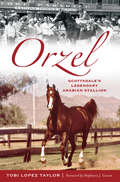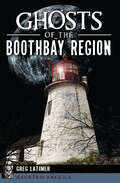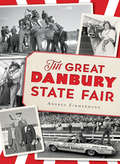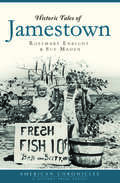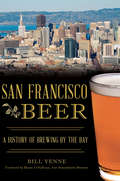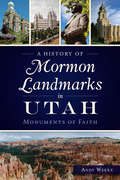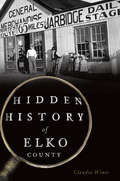- Table View
- List View
Exploring Biltmore Estate from A to Z
by Chris KinsleyThis entertaining seek-and-find alphabet book invites you to explore twenty-six must-see places at Biltmore Estate, offering beautiful photographs, clever rhymes and hidden animals on every page. Children will discover everything from colorful gardens and underground tunnels to towering rooftops and lively farm animals. Included are fun facts about Biltmore's history in an illustrated glossary and a kid-friendly map for planning your journey. Whether you use this book as a guide for an upcoming visit to Biltmore or as a souvenir to commemorate your stay, a magical adventure awaits you and your family!
Hispanic & Latino Heritage in Virginia (American Heritage)
by Christine StoddardLong before the adventures of John Rolfe and Pocahontas, Spanish ships reached Virginia's shore. In the centuries that followed, Hispanics and Latinos settled in Virginia to seek new opportunities away from home. The 1980s saw the beginnings of el Nuevo Sur, or the New South, as Virginia's Latin American population surged. Since then, the now-defunct Virginia Center for Latin American Art briefly showcased Virginia's Latino and Hispanic evolving arts heritage. Restaurants like Pollo Campero and La Tasca have joined the local culinary scene, and schools and churches have forged plans for their changing communities. Join author Christine Stoddard as she traces the vibrant history and culture of Hispanics and Latinos in Virginia.
Independent Press in D.C. and Virginia: An Underground History
by Dale M. Brumfield Katya Sabaroff TaylorThe nation's capital and the state of Virginia were a hotbed of political and social turmoil that marked the 1960s and 1970s. The area saw anti-Vietnam War protests, civil rights marches and students clamoring for a cultural revolution. Underground publications in D.C. and Virginia sprang up to document the radical change and question the "straight media." Off Our Backs led the charge for women's equality. The Gay Blade fought for the rights of homosexuals. Even the FBI began infiltrating the underground press movement by planting informants and creating fake magazines to attract suspicious "radicals." Join author and former underground editor Dale Brumfield as he traces the history of alternative press in the Commonwealth and the District.
A Brief History of Bucktown: Davenport's Infamous District Transformed (Brief History)
by Jonathan TurnerGerman immigrants created leafy beer gardens here nearly two centuries ago, establishing Bucktown as the heart of entertainment in downtown Davenport for generations. In 1916, the founding of the Tri-City Symphony Orchestra at the Burtis Opera House embodied the neighborhood's reputation for high culture. The numerous saloons and theaters, as well as the forty-two documented brothels that flourished within two blocks, lent a bawdy side to the good times. Varied industries thrived through World War II, and downtown bustled with shoppers visiting department stores like Petersen's. Later, the neighborhood struggled and declined as a farming crisis hit the region hard. With revitalized landmarks like the magnificent Hotel Blackhawk and the historic Redstone Building, the community is growing more vibrant as a place to live, work and play. Author Jonathan Turner explores this dynamic history and transformation.
Wicked Mobile (Wicked Ser.)
by Brendan KirbySince its founding in 1702 as the first capital of the French colony of Louisiana, Mobile has witnessed all manner of salacious scandals. An 1847 murder resulted in the hanging of Charles Boyington, who maintained his innocence to the very end, and a great oak tree near his grave site seems to support him. Many believe the notorious Copeland gang started one of the city's worst fires as cover to escape with stolen loot. A 1932 murder case involved a slaying at the landmark Battle House Hotel and proved that Mobile juries could not always be trusted. Local author Brendan Kirby revives Mobile's history of gangsters, gambling, theft and arson.
Connecticut Pirates & Privateers: Treasure and Treachery in the Constitution State
by Wick GriswoldThe waters, inlets and islands of Connecticut once swarmed with fabled corsairs like Captain Kidd and Blackbeard who may have buried their booty in Constitution State soil. In colonial times and through the nineteenth century, over one hundred privateers used the Connecticut River and waterways as a home port, influencing the geopolitics of the time. During the Revolutionary War, the infamous traitor Benedict Arnold attempted to destroy the state's privateer fleet. In 1779, Captain Elisha Hinman cleverly devised a system that allowed the large privateer ship Governor Trumbull to avoid enemy attack by becoming super-buoyant and passing over dangerous shoals. Wick Griswold uncovers the swashbuckling stories of Connecticut's pirates and privateers, brimming with historical facts and local myths.
Austin in the Jazz Age
by Richard ZeladeThough renowned, Austin's contemporary music scene pales in comparison with the explosion of creative talent the city spawned during the Jazz Age. Dozens of musicians who started out in the capital city attained national and international fame--but music was just one form of artistic expression that marked that time of upheaval. World War I's death and destruction bred a vehement rejection of the status quo. In its place, an enthusiastic adherence to life lived without question or consequence took root. The sentiment found fertile soil in Austin, with the University of Texas at the epicenter. Students indulged in the debauchery that typified the era, scandalizing Austin and Texas at large as they introduced a freewheeling, individualistic attitude that now defines the city. Join author Richard Zelade in a raucous investigation of the day and its most outstanding and outlandish characters.
Austin Murder & Mayhem (Murder And Mayhem Ser.)
by Richard ZeladeAustin&’s past is as weird as its present—including murderous neighbors, deadly political antics, and a serial killer suspected to be Jack the Ripper. Beneath Austin&’s shiny veneer lies a dark past, filled with murder, lechery and deceit. Legislators, lawmen and lawyers killed, robbed and lied just as well and just as often as the drifters and grifters preying on newcomers. The nation&’s first known serial killer made his debut in Austin in the form of the Servant Girl Annihilator, who is still rumored to be Jack the Ripper. After the Willis brothers murdered their neighbors over rumored buried gold, a lynch mob hanged the boys from live oaks on present-day Sixth Street. Freshman representative Louis Franke died after he was robbed and beaten on the steps of the statehouse. Author Richard Zelade delivers a fascinating look at the seedier side of Austin history. Includes photos!
Vermont Prohibition: Teetotalers, Bootleggers & Corruption (American Palate)
by Adam KrakowskiVermont became the nation's second dry state in 1853. But some locals refused to comply, and inept law enforcement led to ineffective consequences. What was intended to increase wholesomeness forced a newly carved detour toward crime and corruption. Early laws, such as the Liquor Law of 1853, targeted distilled spirits while conveniently protecting cider. As regulations tightened, morals loosened. Without legalized booze, smugglers imported liquor from Canada, and bootleggers ensured that domestic speakeasies kept the liquor flowing. Crime ran so rampant that Newport, Richford and Lyndonville residents relocated to escape rum-running gangs. Join author Adam Krakowski as he discloses the tumultuous side of Vermont's temperance movement.
Michigan Civil War Landmarks (Civil War Series)
by Karin Risko David IngallWhen America faced its greatest internal crisis, Michigan answered the call with over ninety thousand troops. The story of that sacrifice is preserved in the state's rich collection of Civil War monuments, markers, forts, cemeteries, reenactments, museums and exhibits. Discover how General George A. Custer and the famed Michigan Cavalry Brigade "saved the Union." Visit the chair that President Lincoln was assassinated in at Ford's Theatre, and view the grave of the last African American Union veteran. With a foreword by Civil War historian Jack Dempsey, this work is the first of its kind to chronicle the many Civil War landmarks in the Wolverine State.
Eaton Hall: Pride of King Township
by Steve Pellegrini Kelly MathewsIn 1901, Florence McCrea married into one of the most prosperous families in the Dominion of Canada, becoming Lady Eaton fourteen years later when her husband, John Craig Eaton, was knighted. Not long after the death of her husband, Lady Eaton retired from her home in Toronto to the seventy-two-room, Norman-style chateau she had built on their King City property. She named it Eaton Hall. The estate fueled the local economy and community, supported the Canadian World War II effort and established a firm place in the hearts and minds of the residents of King Township. Rediscover an enchanting and bygone age with the life and history of Lady Eaton and her grand Eaton Hall.
Oklahoma's Bennie Owen: Man for All Seasons (Sports)
by Gary King Jay WilkinsonBefore Bob and Barry, even before Bud, there was Bennie, and he might have been the best of them all. He was certainly the most innovative. Best remembered as the mentor of the University of Oklahoma's football team from 1905 through 1926, Bennie Owen also coached baseball and basketball and served as the director of athletics. He retired as intramural director at the age of seventy-five. A visionary and a builder, he exerted the driving force that created the university's Memorial Stadium, one field house, Memorial Union building, men's swimming pool, baseball field and bleachers, concrete tennis courts, nine-hole golf course and intramural playing fields. A true man of all seasons, he laid the foundation for a Sooner tradition of excellence--in football and beyond.
Southern Oregon Timber: The Kenneth Ford Family Legacy (Transportation)
by R. J. GuyerForestry defined the culture of southern Oregon. Kenneth and Hallie Ford rose from humble beginnings with a single sawmill during the Great Depression and helped transform the state's timber industry. They founded one of the largest privately owned wood-products companies in the country, bringing the title "Timber Capital of the Nation" to Roseburg, Oregon. Their legacy remains today through the Ford Family Foundation, dedicated to educational grants and community improvements. Author R.J. Guyer explores the evolution of logging and the challenges faced by the hearty men and women who plied this trade.
A Theatre History of Marion, Ohio: John Eberson's Palace And Beyond (Landmarks)
by Scott L. HoffmanOne of the last remaining atmospheric theatres in the nation, elegant Marion Palace Theatre holds a storied history behind its curtains. From the "Wigwam," the Grand Opera House and Germania Park Pavilion to nickelodeons, vaudeville houses and movie theatres, performance has been an essential part of Marion's history, and the Palace is the city's jewel. Designed by renowned theatre architect John Eberson, the Palace opened its doors in 1928 to packed audiences of over three thousand patrons. Author Scott L. Hoffman delves into the life and work of John Eberson and the forgotten stories of the Palace that include a police gambling raid, the construction of the theatre and the stars who performed for dazzled audiences there.
Des Moines Architecture & Design
by Jay PridmoreDes Moines boasts a remarkable architectural portfolio rich in depth and quality. The town drew wide attention in the nineteenth century with structures like the Iowa State Capitol and the Terrace Hill mansion. Des Moines embraced the City Beautiful movement in the twentieth century and became home to well-known work by Eliel and Eero Saarinen, notably the city's innovative Art Center. A contemporary architectural renaissance produced lauded landmarks like the Meredith Headquarters, the Des Moines Public Library and the John and Mary Pappajohn Sculpture Park. Author Jay Pridmore crafts an illustrated survey of the architecture and design of Iowa's largest city.
Pembroke Chronicles (American Chronicles)
by Karen Cross ProctorIn its earliest days, Pembroke offered abundant fishing and lush forests for its Native American inhabitants. Starting in the 1640s, European colonists began turning the town from a farming community into a successful hub for shipbuilding. Pembroke's long history is colored by remarkable stories. Atop the old Pembroke Public Library rests a bee sculpture designed by Pembroke artist Richard Edlund, representing the spelling bees held each spring at the library since 1875. The Pembroke Monument Association first met in 1879 to discuss the purchase of a Civil War soldiers' monument for the town, yet it was nearly a decade before the monument was erected. In this collection of articles from her "Pembroke's Past" column, Karen Cross Proctor captures the spirit of the community.
Only in Asheville: An Eclectic History
by Marla Hardee Milling Leslie Mccullough CasseA unique blend of visionaries, risk takers and creative souls lends energy to Asheville's historic streets. Today, bohemian street performers, funky shops, exquisite art galleries, restaurants and craft breweries blend in among some of the most revered vintage architecture in the country. Discover quirky figures like a "nun" named Sister Bad Habit, who entertains passengers on the LaZoom bus; the "Man in White" living statue; and Asheville's Village Witch. Be inspired by innovative dreamers such as Julian Price, who invested millions in the once-desolate downtown Asheville, giving money to an eclectic mix of restaurateurs and shop owners. Author Marla Milling traces the people and places that make her hometown a truly unique city.
Union Station in Denver (Landmarks)
by Rhonda BeckOn June 1, 1881, Denver's Union Station opened as the largest structure west of the Mississippi. The station welcomed people from all walks of life, from pioneers and miners to U.S. presidents and Buffalo Bill Cody--and even royalty from abroad. It served as the center point for transporting cargo to Denver before the rise in popularity of air travel. Due to revitalization efforts, Union Station is the centerpiece of the nation's largest transportation hub and the pride of the city. Author Rhonda Beck explores the history and stories behind one of the Mile High City's most iconic historic landmarks.
Orzel: Scottsdale's Legendary Arabian Stallion (Sports)
by Stephanie J. Corum Tobi Lopez TaylorIn 1967, Scottsdale's longtime Arabian horse breeder Ed Tweed embarked on a mission to race the horses he bred. He imported a chestnut stallion from Poland named Orzel, or "Eagle" in English, that flew past competitors to become the first U.S. National Racing Champion. Among other wins in halter and performance, Orzel was the victor in the debut of the U.S. National Championship Ladies' Sidesaddle category, partnered with Tweed's granddaughter Shelley Groom Trevor. Thousands of fans visited the legendary performer in retirement at Brusally Ranch. Decades after Orzel's death, horses he sired continue his winning legacy. Author Tobi Lopez Taylor chronicles this triumphant story.
Ghosts of the Boothbay Region (Haunted America)
by Greg LatimerThe pine-forested rocky coast from Boothbay to Southport hides dark mysteries and eerie haunts. Meet the ghosts of Mainers past who just could not leave this picturesque shore life, even in death. The soul of a lighthouse keeper's wife seems to linger on Burnt Island. The spirits of the Opera House remain hidden behind the curtain but come out to play when the living are away. One local might even have returned from the grave to greet his neighbors on a brisk spring afternoon. Investigative reporter Greg Latimer takes a journey to the Boothbay region's haunted side, where the ethereal residents are unrestrained by mortal bonds.
The Great Danbury State Fair (Landmarks Ser.)
by Andrea ZimmermannThe first Danbury Fair was held under a borrowed tent in 1869. Over the next 112 years, the fair expanded to a ten-day event, earning a national reputation for its themed villages, giant figures, grandstand shows and wildly popular stock car races. The twelve formal venues for music and entertainment on the fairground included the World of Mirth Theater and the Orange Bowl Stadium. Under the management of oil magnate John W. Leahy, the fair retained its great hometown appeal as city dwellers flocked to the fair by the thousands. Venture back to the autumn days of zany ostrich races and Zembruski's polka music with Andrea Zimmermann as she explores the beloved bygone tradition of the Great Danbury State Fair.
Historic Tales of Jamestown (American Chronicles)
by Sue Maden Rosemary EnrightDiscover the fascinating history of Jamestown, from tales of shipwrecks to summer days long past. The town was home to Camps Bailey and Meade, two training facilities for Union troops during the Civil War. When the steam ferries crossed the bay beginning in 1873, people traveled to the island to sample the town's leisure and entertainment opportunities. Beavertail Lighthouse and the breathtaking Clingstone stand as iconic landmarks centuries after their construction. After the Jamestown Bridge opened in 1940, suburban development on the North End mostly replaced the hotels along the waterfront. Local authors Rosemary Enright and Sue Maden reveal stories of Jamestown's past and evolution in this captivating collection of essays.
San Francisco Beer: A History of Brewing by the Bay (American Palate)
by Bill Yenne Shaun O'SullivanThe story of beer in San Francisco is as old as the city itself. San Francisco had its first commercial brewery by 1847, two years before the gold rush, and went on to reign as the major brewing center in the American West through the nineteenth century. From the 1930s to the early 1950s, iconic San Francisco-based breweries Lucky and Acme owned the statewide California market. In the 1960s, Fritz Maytag transformed San Francisco's tiny and primitive Anchor Brewing into America's first craft brewery. Now, well into its fourth generation of craft breweries, San Francisco has seen more new breweries open in the second decade of the twenty-first century than were opened in the entire previous century, proving that tech is not San Francisco's only booming industry. Join local author and beer enthusiast Bill Yenne as he explores San Francisco's rich tapestry of beers and breweries that have made it a brewing capital in the West.
A History of Mormon Landmarks in Utah: Monuments of Faith (Landmarks)
by Andy WeeksThe home state of The Church of Jesus Christ of Latter-day Saints is a land of rugged mountains, deep canyon lands and majestic rivers. Utah and Mormon history are entwined, as so many early followers of the faith settled the region beginning in 1847. They preserved their values and heritage in the numerous temples, forts, tabernacles and cemeteries that serve as historic sacred monuments for the modern church. Author and LDS member Andy Weeks explores the history behind the landmarks that exalt the rich, deeply rooted history of Mormonism in the Beehive State.
Hidden History of Elko County (Hidden History)
by Claudia WinesElko County in Nevada's remote northeastern corner has long attracted independent, spirited individuals determined to carve out lives of their own. Born to former slaves, Henry Harris worked his way from John Sparks's house hand to one of the most respected buckaroos in the region. Pete Itcaina, the unlikely millionaire, once bought a local bar on the spot just to fire the bartender, who mistook Itcaina for a bum and refused to serve him. The beautiful cattle rustler Susie Raper charmed her way out of numerous arrests and trials, despite her trail of dead husbands. Local author Claudia Wines excavates sagas buried in the dust and probes conventional wisdom surrounding local legend.
